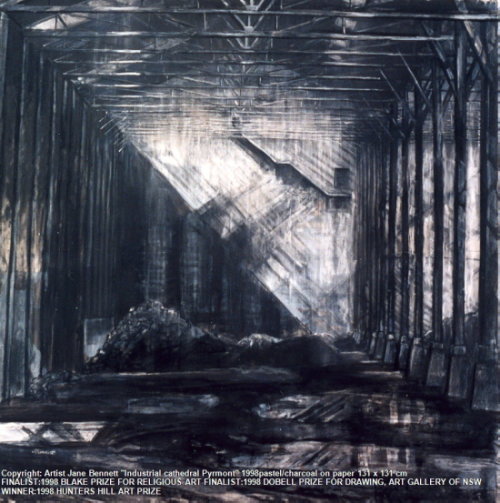Invitation to an exhibition:
'Beyond the Sea'
: an exhibition held by the Sydney Heritage Fleet and ASMA, The Australian Society of Marine Artists.
Opening night : Friday 26th November 2010 6 - 8pm
Wharf 7, Pirrama Road, Pyrmont 2009
Opening night admission : $10
RSVP Friday 19th November : please call (02) 9298 3888
The exhibition continues until 12th December
Hours 10am - 3pm
Admission free on all other days except for opening night
Donation to the Sydney Heritage Fleet
I am donating this painting - it will be raffled and all proceeds are being donated to the Sydney Heritage Fleet
 |
| 'The Tall Ship 'James Craig' at Darling Harbour' 2003 oil on paper 48 x 37 cm
This is painted opposite Wharf 7, the headquarters of the Sydney Heritage Fleet.
|
I will be one of the featured artists in this exhibition as my paintings depict historic moments in the development of both Pyrmont and Barangaroo.
This canvas was painted from the roof of the old Pyrmont Power Station, now replaced by Star City Casino.The pile of rubble in the centre is an old signal box in the Pyrmont Goods Yard, the 'Spanish Cafe' in Baz Luhrman's classic Australian film 'Strictly Ballroom'. The bright red ship in the background is the notorious 'Tampa'!
In the early 1980's,when I first started to paint in Pyrmont, the building in the centre of this painting was the site of Pier 13, where so many immigrantss first set foot on Australian soil. It was still connected to Jones Bay Road by an elegant land bridge. Later Pier 13 became the temporary casino, was painted a hideous shade of yellow and the land bridge was demolished. Pier 13 has since been replaced by 'Workplace6', home of 'Google' and Paul Signorelli's restaurants 'Gastronomia' and 'Biaggio'.
Curving under the bridge is the old Pyrmont goods line, built in 1916, which looped through Darling Harbour and around Pyrmont across Wentworth Park and beyond. At vast expense, this goods line was torn up and replaced by the dubious benefit of light rail.
I have painted Pyrmont's metamorphosis from an industrial wasteland to a media and entertainment hub over a 30 year period. I painted from dozens of business and residential premises, painting panoramas of the dramatically changing urban landscape from rooftops, chimneys, demolition sites and even the summit of the half completed Anzac Bridge.
I will exhibit some of my Barangaroo paintings in this venue,showing the area's exciting transition from a working port to the preparations for its transformation into Sydney's new cultural and economic hub. I have been 'Artist in Residence' at Barangaroo since the early 2000's, compiling an archive of all the changes and so far I've maintained my position throughout the area's change of owners. I was granted unprecedented access to paint this area as a working port by Sydney Ports Corporation, Patrick Corporation and P & O. Now I am starting to paint the demolition and construction activities at Barangaroo South.
This is Barangaroo as it used to be as a working port. Compare this painting with the empty wharf paintings that follow. Jeffrey Smart, eat your heart out!
 |
| 'The empty wharf'2007 oil painting on canvas 100 x 122cm
Enquiries about these and other Millers Point, East Darling Harbour Wharves and Barangaroo paintings:
|
The 2 horizontal paintings were painted from the same viewpoint exactly 1 year apart.
















